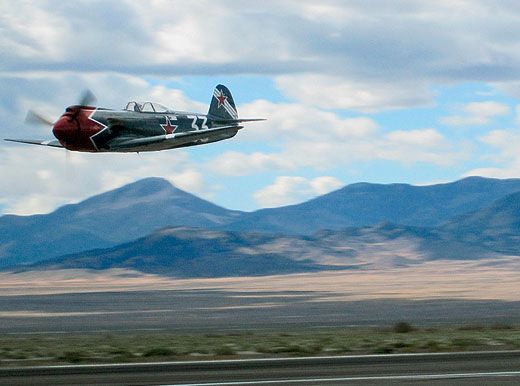One Fast Yak
How Will Whiteside and his team transformed a light trainer into a racer.
/https://tf-cmsv2-smithsonianmag-media.s3.amazonaws.com/filer/moments_and_milestones_03012012_1_FLASH.jpg)
One could argue that when Will Whiteside set a new speed record— 416 mph for a three-kilometer closed course—last October, it was really a demo flight. His Yak-3U, manufactured in 2005, has very little time on it; it hasn’t even lost that new-airplane smell. It’s also for sale. “Always has been,” says Whiteside. Sure enough, Worldwide Warbirds of Chino, California, has it posted. Asking price: $500,000.
Whiteside, a former airline pilot and motorcycle racer, flew to the Reno air races one year with Lloyd Hamilton in Hamilton’s Unlimited-class racer, a Hawker Sea Fury named Baby Gorilla. After watching Hamilton take the Gorilla once around the pylons, Whiteside determined he would compete at Reno someday, somehow. “The initial plan was to buy a Sea Fury,” he says, to follow in the footsteps of Hamilton, who died in 1999, but instead he worked his way up, debuting in 2005 with a Glasair III in Sport Class and finishing second in Sport Bronze. Then he heard about the Yak.
The one Whiteside flies was born in Romania at the Avioane Craiova company, and it was intended as a trainer. He says it was the last propeller-driven fighter made by the Romanians, and instead of its original radial Shvetsov ASh-82FN, it’s now wearing a Pratt & Whitney R-2000 7M2 with anti-detonation injection (ADI) to boost power. Engineered by Pete Law, former thermodynamics department manager at Lockheed’s Skunk Works, the system squirts a 50-50 mix of water and methanol into the 14 cylinders, where the alcohol combusts and the water absorbs some of the combustion heat, allowing the engine to operate smoothly at higher power settings. The stock R-2000 that powered the DC-4 and the big twin-engine Caribou, a Canadian military transport, makes about 1,450 horsepower, Whiteside says. With ADI, he’s getting about 1,750 ponies.
That’s a lot of engine for a small, light trainer that weighs only 5,300 pounds empty, less than 70 percent of the weight of a standard P-51D Mustang. To transform the trainer into a racer—SteadFast—Whiteside and his team rebuilt much of the airplane, replacing the canopy, the prop, and the spinner along with its afterbody. Like the Sea Fury, this Yak is cowled extremely tightly for speed. Ram air enters through a circular slot around the spinner, then the afterbody—think of it as the mirror image of the spinner and mounted behind it: two cones base to base—allows the air to expand smoothly, which slows it so it can cool the hot cylinders more efficiently. “It’s got one of the tightest spinners at Reno,” Whiteside says. “But we only cool well when we’re doing more than 300 [mph] indicated [airspeed] at high power. It’s built for speed.”
Whiteside says one of his engineers asked him if he’d ever thought about breaking a record. “I was thinking we can’t ever go faster than [Rod Lewis’s Grumman Bearcat] Rare Bear. He told me, ‘You don’t have to, dummy, you can beat the Hughes [H-1] Racer. Go for a weight class.’ ” The late Jim Wright set the record for propeller aircraft under 6,600 pounds, flying his replica H-1 in 2002 at 304 mph. (Howard Hughes set the unlimited record in 1935, with a speed of 352 mph. The story that his attempt went for naught due to a paperwork error is an urban legend, says the National Aeronautic Association, and the staff there have the evidence to prove it.)
Next up for the little Yak is an attempt at the time-to-climb record. The big spinner will have to come off, but the airplane’s low weight should be an important advantage. After that, maybe the price will go up.
